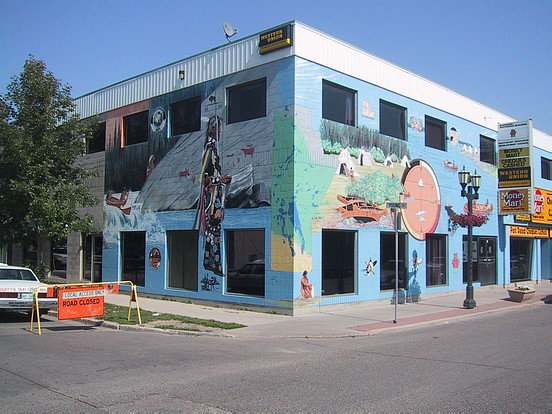|
|
|
|
511 Ellice Avenue

This wall was designed and rendered by Dave Carty in 1998, with sponsorship by West End BIZ. 20 years later in August of 2018 it was painted over with a new Mural. Original notes follow:
Dave Carty: "Going from right to left the illustration begins with Ojibway in a
canoe (Photo 3)
hunting a moose in the traditional way. It then moves into a circle known to
the First Nation's people as the medicine wheel. This symbol, central to
Native culture, represents the close relationship the natives have with the
natural world. The Logos of the nine communities joined in business
partnership do not include the community names as I felt that this would be
visually 'too busy' for the Mural."
"Beside the medicine wheel is a native
encampment as it would have been pre-contact and shortly thereafter.
Wrapping around the building is the province of Manitoba (Photo 1) giving sense
where these communities are. I felt this would be an interesting shape that
could further draw the viewer around the corner with a pleasing flow.
Continuing is a large rock face with pictographs (Photo 2). More pictographs
then
follow a medicine man in full dress. I have chosen these elements because
of the power and depth they bring into the story of the Mural and the First
Nations people. The symbols shown in the pictographs are taken from a
Berens River pictograph site and a Bloovien River pictograph site. The
Midewinwin society, specific to the Mide (medicine man), had great powers
they that sometimes obtained through 'the men in the rock.' The
tradition of First Nations people is held high for the herbal medicine and
healing powers of the supernatural."
"Next a large freight-like canoe is
shooting the rapids while others portaged the valued goods. The natives had
a tremendous impact on the fur trade that eventually changed their
traditional ways that had previously survived for thousands of years. I will
add that the accounts in this drawing, I believe, are accurate. I have sought
advice and help from our regional archaeologist in Kenora plus a cultural
ethnologist dealing with historic native issues. Most of my representations
have been drawn from turn of the century photographs to further ensure
historic accuracy."
|
Displaying Photos 1-3 of 3
|
|